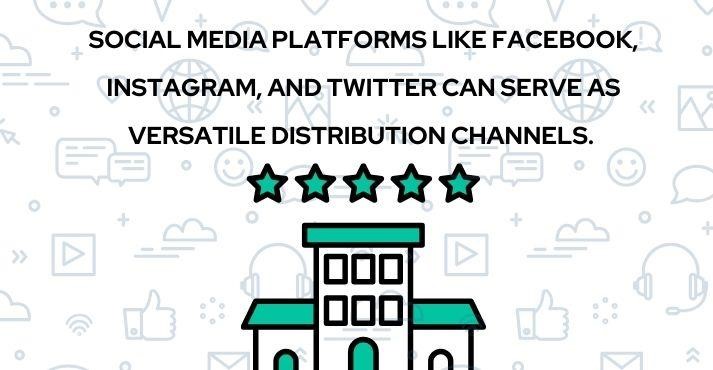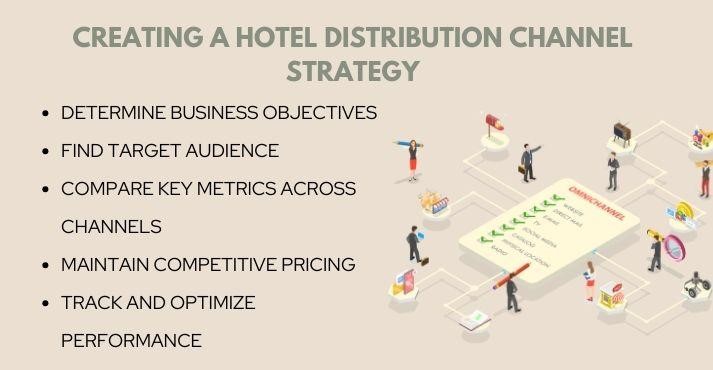Understanding and mastering your distribution channels is crucial when running a successful hotel. Your choice of distribution channels can significantly impact your hotel’s profitability, and finding the right balance between direct and indirect channels is the key to success.
This comprehensive guide uncovers various hotel distribution channels for you, breaking down the options, strategies, and real-world examples to help you navigate the best option for your business.
There’s no one-size-fits-all solution when it comes to distribution channels. Your ideal mix will depend on factors like your target audience, the competition in your market, and your available budget.
From securing direct bookings through your website to partnering with online travel agencies (OTAs) and harnessing the power of Global Distribution Systems (GDSs), we’ll explore the full spectrum of options.
Join us as we aim to optimize your hotel’s distribution strategy, helping you reach a broader audience and ultimately reach your goals.
Whether new to the hotel business or a seasoned pro, this guide will equip you with the knowledge you need to thrive in a competitive hospitality industry!
What Is a Hotel Distribution Channel?
In the hotel industry, a “distribution channel” is a vital concept that directly impacts a hotel’s ability to reach potential guests, secure bookings, and, ultimately, maximize revenue.
Simply put, a hotel distribution channel is a route or a platform through which your hotel’s rooms are available to potential guests for booking.
These channels connect your hotel to travelers, and there are two main categories: direct and indirect distribution channels.
- Direct Distribution Channels: These are channels where guests book directly through the hotel. This includes your hotel’s official website, mobile apps, or contacting the hotel by phone. Direct bookings typically result in higher profit margins for hotels because they involve no third-party commissions.
- Indirect Distribution Channels: Indirect channels are intermediaries that facilitate bookings on behalf of your hotel. They include online travel agencies (OTAs), global distribution systems (GDSs), travel wholesalers, and tour operators. While they may charge commissions, these channels can expand your hotel’s reach by tapping into their extensive networks and customer bases.
A well-balanced mix of direct and indirect channels can help hotels reach a wider audience, increase occupancy rates, and ultimately boost revenue.
Understanding the function and role of each channel and how they can work together is essential for a hotel’s success in modern hospitality.
Importance of Distribution Channels for Hotels
Hotel distribution channels are the backbone of a hotel’s sales, distribution, and revenue strategy. In today’s ever-evolving travel landscape, they play a critical role in a hotel’s ability to connect with travelers, secure bookings, and optimize revenue. Let’s explore why these channels are of paramount importance for hotels:
Over the last six decades, the world of travel has undergone a remarkable transformation. Back in 1950, a mere 25 million individuals embarked on global travel, limited mainly to the well-trodden paths of Europe and North America.
Fast forward to today, and over 1 billion people journey across the globe annually, with a growing interest in exploring emerging economies.
As a hotelier, you have multiple rooms to sell each night your property is open, be it 10, 20, 50, or even more. To achieve this goal, you must effectively market and promote your rooms through online hotel distribution channels, where modern travelers actively search and make reservations.
Hotel distribution channels provide exposure to a broader audience and simplify the booking process for potential guests. These channels encompass various platforms, from your hotel’s official website and mobile apps to online travel agencies (OTAs) and global distribution systems (GDSs).
Leveraging these channels strategically allows hotels to maximize occupancy rates and revenue, ensuring a steady flow of guests and a thriving business.
Types of Hotel Distribution Channels
Various distribution channels are available to help hotels reach potential guests and secure bookings. These channels can be categorized into several types, each with unique characteristics and advantages.
Let’s explore the most common types of hotel distribution channels:
1. Hotel Website

Your hotel’s official website is a direct distribution channel, allowing potential guests to explore your property, view room options, and make online reservations. A well-designed and user-friendly website is crucial for offering an efficient and personalized booking experience.
It lets you control your pricing, showcase your property’s unique features, and maintain a direct relationship with your guests.
By offering competitive rates and special promotions, your website can be a powerful tool for attracting and converting potential guests, ultimately enhancing your profitability and brand image.
2. Direct Phone Bookings
Direct phone bookings are a traditional method still valuable in the digital age. Some guests prefer the personal touch of speaking directly with a hotel representative.
This channel allows for immediate communication and the opportunity to address specific guest inquiries or requests more personalized.
It can be especially beneficial for guests with unique needs or preferences, providing them with a convenient way to secure accommodations.
3. Social Media

Social media platforms like Facebook, Instagram, and Twitter can serve as versatile distribution channels.
Hotels can use these platforms for both direct and indirect bookings. They provide a space to showcase your property, share engaging content, interact with potential guests, and enable direct bookings through integrated tools and features.
Social media offers a dynamic and visually appealing way to reach a broad audience, build your brand, and engage with your customers in real time. It’s a valuable channel for creating brand awareness, influencing travelers’ decisions, and driving bookings.
4. Online Travel Agencies (OTAs)
Online travel agencies (OTAs) are third-party platforms where hotels can list their rooms for booking. OTAs offer extensive exposure to a global audience of travelers searching for accommodations.
They are vital in increasing a hotel’s visibility, particularly among independent travelers and international guests. While OTAs charge booking commissions, they provide a convenient and trustworthy platform for guests to compare rates, read reviews, and secure reservations.
Major OTAs like Expedia, Booking.com, and Agoda dominate the online booking market, and partnering with them can effectively fill your rooms and reach a diverse customer base. However, it’s crucial to carefully manage OTA relationships to balance your distribution strategy and optimize profitability.
5. Global Distribution Systems (GDSs)
Global Distribution Systems (GDSs) are primarily used by travel professionals such as travel agents and corporate travel planners. These systems provide access to a vast network of agents who can book client accommodations.
GDSs are particularly beneficial for hotels aiming to capture the corporate travel market. They offer exposure to a global audience and a seamless booking process for travel agents.
While GDSs typically involve fees and commissions, they can be a valuable indirect distribution channel for attracting business travelers who often rely on travel agencies to arrange their accommodations.
6. Tour Operators
Tour operators are intermediaries that bundle hotel accommodations with other travel services such as flights, tours, and activities. Partnering with tour operators can help hotels tap into a broader customer base, particularly in the leisure and group travel sectors.
These operators often have established distribution channels and hospitality marketing strategies to promote your property to travelers seeking packaged travel experiences.
Collaborating with tour operators can diversify your distribution strategy and boost occupancy during peak travel seasons and events. However, it’s essential to negotiate favorable terms and contracts to ensure profitability when working with tour operators.
7. Metasearch Engines
Metasearch engines allow users to compare prices and availability across multiple distribution channels. They aggregate information from various sources, including OTAs and hotel websites, and present it in an easy-to-compare format.
While metasearch engines do not directly handle bookings, they play a crucial role in the research phase of travel planning. Travelers often use metasearch engines to find the best deals and availability for their desired accommodations.
By managing your presence on metasearch platforms and offering competitive rates, you can influence travelers’ decisions and drive direct bookings from these channels.
8. Wholesalers
Wholesalers are intermediaries that purchase rooms in bulk from hotels and resell them to retailers like travel agencies and tour operators. This distribution channel benefits hotels seeking to sell a significant portion of their room inventory in advance.
Wholesalers often provide hotels with a guaranteed volume of bookings, making them beneficial for filling rooms during low-demand periods. However, it’s essential to strike a balance between wholesaler agreements and other distribution channels to ensure revenue optimization.
Managing relationships with wholesalers requires careful negotiation and contractual agreements to maintain profitability and control over your room rates.
9. Destination Marketing Organizations (DMOs)
Destination Marketing Organizations (DMOs) promote a specific destination to attract travelers. DMOs often have websites, visitor centers, and marketing campaigns that indirectly influence travelers to choose specific hotels within the destination.
Collaborating with DMOs can increase your property’s visibility and reputation, mainly if your hotel is in a tourist-driven location.
By participating in DMO initiatives and ensuring your hotel is prominently featured on their platforms, you can benefit from the collective marketing efforts of these organizations to attract travelers to your area.
10. Offline
Offline distribution channels include traditional methods of booking accommodations. While these channels have become less prevalent in the digital age, they can still be relevant in certain markets or for specific customer segments.
These offline channels may include walk-in bookings from travelers who prefer to secure rooms in person, travel agencies that assist in booking accommodations, and printed brochures or promotional materials distributed through various channels.
While these methods are less common today, they can still serve as a supplementary means of securing hotel bookings catering to diverse guest preferences and markets.
Understanding each distribution channel’s strengths and unique characteristics is essential for hoteliers. By strategically utilizing these channels, hotels can optimize their reach and revenue, ultimately enhancing their competitiveness in the hospitality industry.
How to Create a Hotel Distribution Channel Strategy?

In the dynamic world of hotel management, crafting a robust distribution channel strategy is the linchpin of success. A well-thought-out strategy helps hotels reach their target audience effectively and maximizes revenue.
Let’s explore the essential steps for creating a hotel distribution channel strategy.
1. Determine Your Business Objectives
The foundation of any distribution channel strategy lies in understanding your business objectives. Do you aim to increase occupancy rates, boost direct bookings, or target specific market segments? Clearly defining your goals can shape your distribution strategy to align with these objectives.
Whether it’s revenue growth, brand visibility, or customer acquisition, your objectives will serve as guiding beacons throughout the strategy development process.
2. Find Your Target Audience
Identifying and understanding your target audience is paramount. Different guest segments have distinct booking preferences. Are you catering to leisure travelers, business professionals, or both? Analyze your historical guest data and market research to paint a clear picture of your ideal customers.
Once you deeply understand your target audience, you can tailor your distribution channels and messaging to resonate with their needs and preferences.
3. Understand and Compare Key Metrics Across Channels
Effective distribution strategies are data-driven. Familiarize yourself with key performance metrics like GOPPAR (Gross Operating Profit per Available Room), hotel RevPAR (Revenue per Available Room), and gross expenditure.
GOPPAR is a particularly vital metric, calculated as (Gross revenue – Gross expenditure) divided by available rooms. It provides a clear view of your hotel’s profitability.
Compare these metrics across distribution channels to pinpoint which contributes most to your bottom line.
4. Maintain Competitive Pricing
Pricing plays a pivotal role in your distribution channel strategy. Ensure your pricing strategy is competitive while considering the unique dynamics of each channel.
Striking the right balance between channel rates is vital to avoid rate parity issues and maintain profitability. It’s essential to offer competitive rates without compromising your hotel’s brand and value proposition.
5. Track and Optimize Performance
Continuous monitoring and optimization are the lifeblood of an effective distribution channel strategy. Regularly track channel performance, considering conversion rates, occupancy, and revenue metrics.
Make data-driven decisions to adjust your strategy, reallocating resources to channels that deliver the best results and scaling back on underperforming ones.
By constantly refining your approach and utilizing dynamic trends in the hospitality industry, you can adapt to changing market dynamics and stay ahead in the competitive hotel industry.
Crafting a hotel distribution channel strategy requires a meticulous approach. Hotels can enhance visibility and boost revenue and guest satisfaction with a well-executed strategy.
Tips to Maximize the Performance of Distribution Channels
In the highly competitive hotel industry, getting the most out of your distribution channels is essential for success. To ensure your hotel stands out and thrives in this digital age, consider these actionable tips to maximize the Performance of distribution channels for hotels.
1. Mobile Friendliness
In the era of smartphones and on-the-go travelers, mobile-friendliness is paramount. Ensure your hotel’s website and booking process are seamlessly optimized for mobile devices.
A responsive design and user-friendly interface allow potential guests to explore your offerings and make reservations from their smartphones or tablets.
This enhances the user experience and positively impacts rankings, as search engines like Google prioritize mobile-friendly websites.
2. Maximize Your Content Reach
Leverage the power of engaging and informative content to maximize your distribution channel performance. Create and share high-quality content that showcases your hotel’s unique features, amenities, and local attractions.
Use compelling visuals and well-crafted descriptions to captivate potential guests. Share this content on your website and various digital platforms, including social media, travel blogs, and relevant online forums.
Expanding your content strengthens your online presence and drives more traffic to your website.
3. Improve Your Online Reputation
A solid online reputation is a game-changer. Encourage guests to leave reviews on TripAdvisor, Google, and OTAs.
Respond to reviews promptly and professionally, whether they are positive or negative. This shows potential guests that you value their feedback and are committed to providing a top-notch experience.
A positive online reputation influences potential guests’ decisions and boosts your rankings on review websites and search engines, ultimately attracting more bookings.
4. Appoint a Channel Manager
Hotel distribution management can be complex and time-consuming. Consider appointing a channel manager, a software or service that automates inventory and rate updates across various platforms.
A channel manager streamlines your distribution process, reducing the risk of overbookings or rate disparities. It allows you to allocate your time and resources more efficiently. It ensures that your hotel’s rates and availability are accurate and up-to-date on all channels.
Incorporating these tips into your distribution channel strategy can significantly enhance your hotel’s Performance.
By embracing mobile-friendliness, expanding your content reach, improving your online reputation, and leveraging a channel manager, you can attract more guests, increase direct bookings, and maximize your hotel’s revenue and profitability.
Conclusion
Hotel distribution channels are dynamic, and mastering them is essential for success. Your distribution strategy can be the key to unlocking increased occupancy rates, revenue growth, and a broader guest base.
We’ve explored essential steps to create a well-rounded distribution channel strategy, from defining clear business objectives to understanding key performance metrics and maintaining competitive pricing.
Remember, a well-crafted distribution channel strategy boosts your hotel’s visibility and revenue and enhances the guest experience. You can attract and retain a loyal guest base by offering convenient booking options and engaging content.
Staying ahead in the fast-paced hospitality industry means embracing innovation, adapting to new technologies, and remaining updated with shifting guest preferences.
With these strategies and tips, you’re well-equipped to navigate distribution channels and take your hotel to new heights of success in the modern era!











